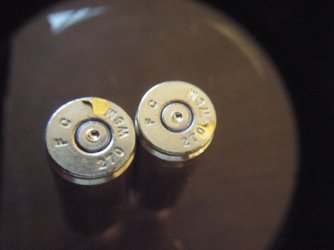Some powders vary more than 1fps per degree of temperature change. Some are less than .01 per degree.Another factor that comes into play is outside temps. Warmer it is, hotter the load is. Put rounds in a cooler to chill them and see if they're still running hot. If you have rounds in a plastic storage box in the sun I can pretty much guarantee theyll be running hot. Learned this on the prairie dog battlefields!
You are using an out of date browser. It may not display this or other websites correctly.
You should upgrade or use an alternative browser.
You should upgrade or use an alternative browser.
plastic flow of primer material
- Thread starter Catbrain
- Start date
 Help Support Long Range Hunting Forum
Help Support Long Range Hunting Forum
I think the brass is too soft before the cases were mfg'd.
no excuse for loose primers on new ammo. i believe that since brass is an alloy-- every batch should be hardness tested before Mfg-ing begins using that batch. Failing to do that is demonstrating an "I don't care" attitude. Or maybe they did test it and they didn't care that it was too soft.
I specifically ordered a lee die set with 4 dies - one being a neck sizing die. But I can't even get to once fired brass when it's this federal. i called federal but there is no human answering the phones -- only a robot. Left msg- no call returned.
I have ordered another brand of brass----
Federal should at least take responsibility enough to answer the phone----especially when it's a safety issue......
no excuse for loose primers on new ammo. i believe that since brass is an alloy-- every batch should be hardness tested before Mfg-ing begins using that batch. Failing to do that is demonstrating an "I don't care" attitude. Or maybe they did test it and they didn't care that it was too soft.
I specifically ordered a lee die set with 4 dies - one being a neck sizing die. But I can't even get to once fired brass when it's this federal. i called federal but there is no human answering the phones -- only a robot. Left msg- no call returned.
I have ordered another brand of brass----
Federal should at least take responsibility enough to answer the phone----especially when it's a safety issue......
I forgot to mention---- the case heads expanded .003 on the once fired rounds. Doesn't that alone demonstrate that factory loading is too hot ? (in addition to the loose primer pocket--- loose to begin with and got looser)
Culpeper
Well-Known Member
- Joined
- Sep 5, 2008
- Messages
- 197
I forgot to mention---- the case heads expanded .003 on the once fired rounds. Doesn't that alone demonstrate that factory loading is too hot ? (in addition to the loose primer pocket--- loose to begin with and got looser)
If there is a bulge. But I wouldn't have reloaded them based on your loose pocket findings. Also, did this box of ammo start off as a known full box of ammo? Federal isn't going to help you based on your description of the rifle not to mention you took what looked like unfired ammo apart. The only thing you determined was you have batch of suspect ammo.
Citified
Well-Known Member
I read everything so far and obviously the brass is unusable. But if all the info suppled was accurate,i.e., rifle purchased used, has anyone borescoped this thing to see about rifling condition? Given the situation, I would want to look for fouling, carbon ring, possible fire cracking etc just to see if it could even be a shooter. If all that looked great, I would load with some starting loads to see how they group and work up from there. Obviously with different brass. 5 minutes with someones borescope would tell you a wealth of information.
Stokesrjsr
Well-Known Member
I've seen this type of high pressure indicators with factory loads several times when there was nothing wrong with the ammo at all. Sometimes it was caused by carbon build up in the throat and some times caused by a short throated chamber.
hoot1848
Member
Helping someone zero their savage 110 in 7mm mag.
He was using some kind of federal. ( I will see the box again
tomorrow) I shot 7 rounds. He didn't have any empty brass so I kept the brass to reload for him. Upon examination of the brass - the primers were fairly well flattened back to the edge of the firing pin and at the outer edges. This gave the impression of a max load. One of the primers showed a further artifact. the brass in the primer had showed plastic flow--- and the material at the outer edge of the primer has flowed out formed a little flap of "foil". It was standing outward like a burr when I first noticed it. I expect it was pushing out between the case head and the bolt face. The perimeter of the primer beside this extrusion showed a lumpy raised area like it just starting to flow.
This is factory ammunition. Now I am asking --- why ?
Two things come to mind. First is---- maybe the ogive is in the lands
when the round is chambered. If it is all ready a max load of powder---
that could give the pressure a kick upwards--- right ? So I will try an unfired round-- measure OAL before and after chambering-- see if it sets back. and I will also ink the ogive and see if I can see rifling marks in the ink. Those two should tell me if the round it loaded too long.
the other issue i am wondering is if the barrel could have lead build up from the previous owner. I took a bright flashlight and shined it in at near right angle to the muzzle and I could see some white looking
residue in the grooves. It didn't look like copper-- as much as it did lead according to the color. I don't understand who would or could shoot lead bullets out of a 7 mm. anyway I cleaned the whole gun and scrubbed the bore for about 20 min with Iosso abrasive bore cleaner. Then did hoppies. It looked somewhat better after. But its very hard to get the light angle right to see in there very far. maybe I need to get it bore scoped. (mine is too big to fit inside) Didn't have any sweets copper cleaner.
I am thinking if the bore is slightly fowled somehow-- that would drive up pressures. I am considering putting a stopper in the muzzle and filling it up with something like CLR to attack the fowling. I have never had to get that "tough" with a bore before---- if I use that how long is a safe time to let it sit ?
This gun was bought used-- so there is that chance it had a hidden problem and that was kept hidden and just sold to the next guy.
My intention was to load him some reduced (like starting loads) using 139 grains at about 2600 to make it easier on his shoulder. But if these things are giving high pressure-- the bad recoil may be another sign of
a problem.
Opinions ?when I come across extreme fouling I use wipe out-patch out let set overnight every night till I can pull patches through that are clean if that is still showing blue(copper) I go to JB BORE PASTE then JB BORE SHINE after JB cleaning there will be zero fouling I've no idea why some folks will not clean their weapon properly or not at all but some people believe that a dirty gun shoots better I've no idea their logic in that but I clean every time I shoot or after 20 rounds sounds like a little bit of neglect has caused a large problem with this one good b luck and be safe
ResearchinStuff
Well-Known Member
Sounds like a chamber issue is at least contributing to what's happening. what's the make of the rifle in question?
I reloaded a 300 RUM about 5 years ago for a friend who couldn't get factory ammo. He had been shooting Barnes ammo. When I was re- priming, the primers went in so easy I was stunned, and actually tapped the primed brass on the bench top and the primer came out. called Barnes and told them what happened. Their reply was that someone loaded them to hot. 
That's because someone did; Barnes. lolcalled Barnes and told them what happened. Their reply was that someone loaded them to hot.
The brass decides what pressure you can run. Nothing else. Certainly not the marketing department.
-----------
Follow on Instagram
Subscribe on YouTube
Amazon Affiliate

Is there some kind of plating that is delaminating in the circular area near the primer? Are the circular areas near the primer where the ejector port is located on the bolt, and is the brass there extruding into the ejector port slighly?I emailed Federal this picture and they responded that it was ok. This was from this year. Factory ammo.
culpepper---- "not to mention you took what looked like unfired ammo apart. "
I don't understand why you think Federal should have a problem with that. It's not their ammo anymore---
are you suggesting I continue shooting a load that shows pressure ? I didn't see any other way to check to see if the unfired factory loads had loose primers. which they did---
i have checked the throat depth--- bullets never touched rifling even when barely in case. I think my scope is bigger than .284 so it prob. cant see a carbon ring or cracking.
i have loaded up some test rounds with a different brand of new brass (starting loads) to see how they shoot. It is a savage 110 in 7mag. will test those today or tomorrow- weather permitting---
I don't understand why you think Federal should have a problem with that. It's not their ammo anymore---
are you suggesting I continue shooting a load that shows pressure ? I didn't see any other way to check to see if the unfired factory loads had loose primers. which they did---
i have checked the throat depth--- bullets never touched rifling even when barely in case. I think my scope is bigger than .284 so it prob. cant see a carbon ring or cracking.
i have loaded up some test rounds with a different brand of new brass (starting loads) to see how they shoot. It is a savage 110 in 7mag. will test those today or tomorrow- weather permitting---
